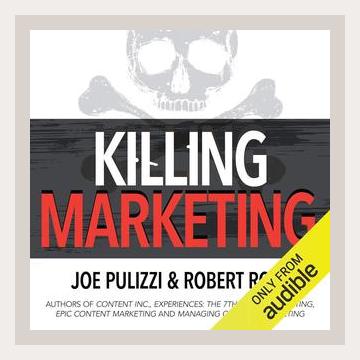Marketing and SalesSocial Media MarketingAdvertisingBrand Management
**
Introduction
“Killing Marketing” by Joe Pulizzi and Robert Rose challenges the traditional view of marketing as a cost center within businesses. Instead, the authors propose a transformative approach where marketing becomes a crucial profit-generating aspect. This book falls under Brand Management, Advertising, and Social Media Marketing categories. It redefines the role of marketing, advocating for a content-driven strategy that aligns with operational efficiency and revenue generation.
The Death of Traditional Marketing
1. Outdated Models: Traditional marketing methods, characterized by interruption and broad messaging, are increasingly less effective in a digital age where consumers have more control over the content they consume.
– Action: Transition from broad advertising campaigns to targeted, engaging content that addresses specific audience needs and interests.
The New Marketing Paradigm
2. Content as a Core Strategy: The authors emphasize the importance of content marketing, where valuable, relevant content is created to attract and retain a clearly defined audience, ultimately driving profitable customer action.
– Action: Develop a comprehensive content marketing strategy that includes blogs, podcasts, videos, and social media posts aimed at providing value to the audience rather than directly promoting products or services.
- Building an Audience: Pulizzi and Rose argue that businesses should focus on building an audience rather than simply generating leads. A loyal audience can lead to multiple revenue streams.
- Action: Invest in platforms like email newsletters and social media communities to nurture and grow a dedicated audience base.
Shifting from Product-Centric to Audience-Centric
4. Monetizing Content: Companies can generate revenue directly from their marketing efforts by monetizing content through subscriptions, events, and paid services.
– Action: Explore diverse monetization options such as premium content subscriptions, hosted events, and sponsored content partnerships.
- Operational Efficiency: With an audience-centric approach, marketing can drive operational efficiencies by integrating seamlessly with sales and customer service.
- Action: Create cross-departmental teams that align marketing with sales and customer support to ensure a cohesive strategy that enhances customer experience.
Real-World Examples of Success
6. Red Bull and Red Bull Media House: Red Bull transformed itself into a media company, creating content that resonates with its audience, such as extreme sports videos and events coverage.
– Action: Emulate Red Bull by identifying content areas that align with your brand and investing in high-quality content production that engages your target market.
- LEGO’s Content-Driven Journey: LEGO’s films and themed content engage children and adults alike, driving both sales and brand loyalty.
- Action: Produce and distribute content that encapsulates your brand’s essence, much like LEGO’s storytelling approach in films and themed YouTube channels.
Transforming Marketing Teams
8. Building Media Properties: Successful companies develop their own media outlets, thus controlling content distribution and avoiding reliance on third-party platforms.
– Action: Launch branded blogs, podcasts, and video channels to establish your brand as a thought leader and content creator in your industry.
- Developing Expertise: Marketing teams need to acquire skills in content creation, journalism, and media management.
- Action: Invest in training programs and hire talent with media and content production expertise to bolster your marketing team’s capabilities.
Innovative Revenue Streams
10. Sponsored Content and Partnerships: Collaborate with other brands to create sponsored content that adds value to both parties.
– Action: Identify potential partners whose audiences overlap with yours and develop joint content initiatives that provide mutual benefits.
-
Premium Services: Offer exclusive content or services such as in-depth reports, white papers, and industry analysis for a fee.
- Action: Develop premium content offerings that cater to specific high-value segments of your audience willing to pay for in-depth insights.
-
Events and Webinars: Hosting industry webinars, workshops, and conferences can establish authority and create additional revenue.
- Action: Plan and host virtual or in-person events that showcase your industry expertise and engage your audience on a deeper level.
Measuring Success and ROI
13. Key Performance Indicators (KPIs): Shift from traditional marketing metrics (e.g., impressions, clicks) to engagement metrics (e.g., content shares, time spent on page) which better reflect audience interest and loyalty.
– Action: Redefine your KPIs to focus on engagement and audience growth metrics that more accurately reflect the success of your content strategies.
- Technology Integration: Implement marketing technology (MarTech) platforms to track and analyze the effectiveness of content marketing efforts.
- Action: Adopt analytics tools and platforms that provide comprehensive data on content performance, audience behavior, and engagement rates.
The Future of Marketing
15. Content Ecosystem: Build an interconnected content ecosystem where all assets drive audience engagement and support the business’s overall objectives.
– Action: Strategize content distribution across owned, earned, and paid media channels to create a cohesive ecosystem that maximizes reach and engagement.
- Iterative Progress: Regularly assess and adapt strategies based on performance data and evolving market trends.
- Action: Conduct periodic reviews of content performance and adjust your strategy based on analytics to ensure ongoing optimization and relevance.
Conclusion
“Killing Marketing” advocates for a fundamental shift in how businesses approach marketing, leveraging content to build audiences, generate revenue, and drive operational efficiency. By adopting an audience-centric model, companies can transform marketing from a cost center into a profit center. Pulizzi and Rose provide practical advice and real-world examples that illustrate how innovative marketing strategies can lead to sustainable business growth.
By utilizing these strategies, companies can foster brand loyalty, create new revenue streams, and position themselves as leaders in their respective industries. The book serves as a guide for marketers looking to innovate and adapt in a rapidly changing digital landscape.
Marketing and SalesSocial Media MarketingAdvertisingBrand Management
